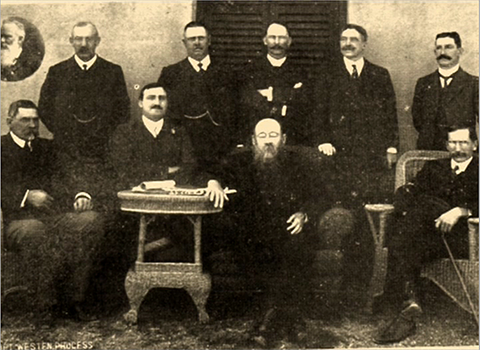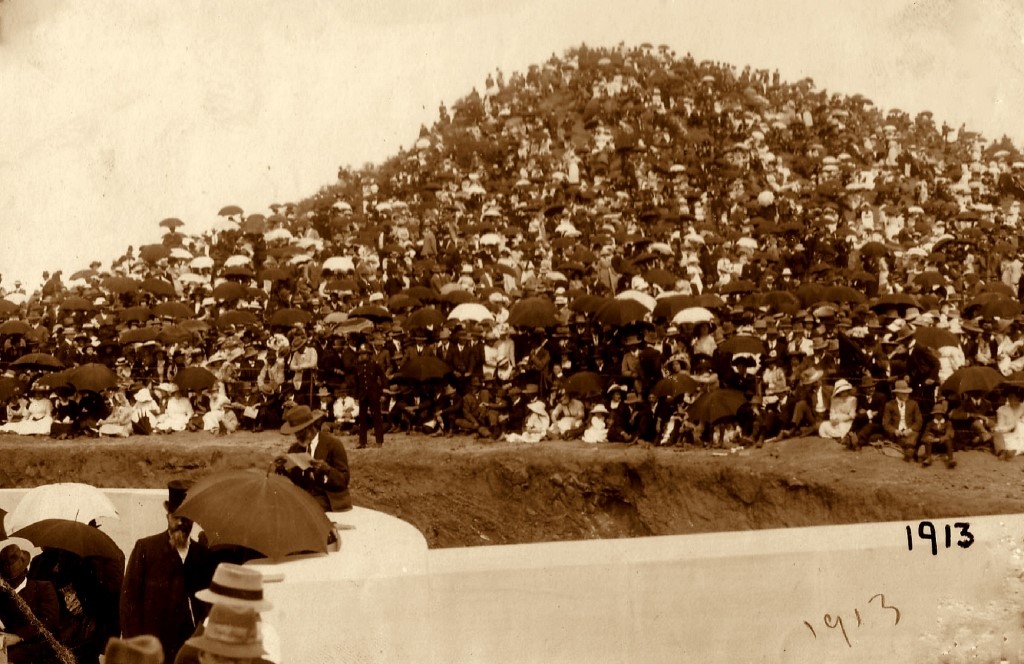History
In 1906, President Marthinus Theunis Steyn, President of th Republic of the Orange Free State (1896-1902), requested that a monument be erected to the thousands of women and children who died in the Anglo-Boer War (1899-1902) in British concentration camps and elsewhere “voor vryheid, volk en vaderland” (for freedom, nation and fatherland). A monument to these women and children instead of a hospital or school would be less expensive, easier to maintain and be more striking and significant.
 He already had this idea during the war and went ahead with the project. On 7 February 1907, a Conference of all the Afrikaans churches and political parties in the then Cape Colony, Free State, Transvaal and Natal was held in Bloemfontein under the chairmanship of Steyn. This resulted in a 4-year fundraising campaign during which R20,000 was collected. On 7 July 1911, a Conference of “landswye verteenwoordiging” (national representatives) decided on the design of architect Frans Soff and sculptor Anton van Wouw. Twelve morgen of land around the knolls to the south of Bloemfontein were accepted as the location for the Monument. The town council donated the land to the Committee. An additional £5,000 was later collected, because Van Wouw’s design would cost £11,000, while President Steyn had earmarked £4000 for maintenance.
He already had this idea during the war and went ahead with the project. On 7 February 1907, a Conference of all the Afrikaans churches and political parties in the then Cape Colony, Free State, Transvaal and Natal was held in Bloemfontein under the chairmanship of Steyn. This resulted in a 4-year fundraising campaign during which R20,000 was collected. On 7 July 1911, a Conference of “landswye verteenwoordiging” (national representatives) decided on the design of architect Frans Soff and sculptor Anton van Wouw. Twelve morgen of land around the knolls to the south of Bloemfontein were accepted as the location for the Monument. The town council donated the land to the Committee. An additional £5,000 was later collected, because Van Wouw’s design would cost £11,000, while President Steyn had earmarked £4000 for maintenance.
The group of sculptures of a woman standing and viewing the dawn of a new day with, in front of her, a dying child on the lap of a grieving woman with a determined look ahead, comes from Emily Hobhouse who saw this event at the Springfontein Station. The wording on the Monument: “Aan onze heldinnen en lieve kinderen” (To our heroines and dear children), “Uw wil geschiede” (Your will be done), “Ik zal u niet begeven en u niet verlaten” (I shall neither forsake nor leave you), and “Voor vryheid, volk en vaderland” (For freedom, nation and fatherland) comes from President Steyn. In the words of President Steyn and the founders of the Monument, these expressions and interpretations of faith for the war and post-war situation live on.
 On Tuesday 16 December 1913, Women’s Day, over 20,000 people assembled for the unveiling at the Monument. President Steyn’s wife, Tibbie Steyn, unveiled the Women’s Monument, because an indisposed Emily Hobhouse had to turn back at Beaufort West.
On Tuesday 16 December 1913, Women’s Day, over 20,000 people assembled for the unveiling at the Monument. President Steyn’s wife, Tibbie Steyn, unveiled the Women’s Monument, because an indisposed Emily Hobhouse had to turn back at Beaufort West.
After the events, President Steyn could thankfully say: “Nu Goddank!” (Now, thank God!).
The National Women’s Monument Commission
Soon after the unveiling of the Monument, this Commission replaced the Executive Committee. Up to his death on 28 November 1916 in Bloemfontein, President Steyn was the Chairman of the Commission. The Commission’s statute provides that it must see to the preservation and upkeep of the Women’s Monument and of everything that is added to the grounds.
Graves in the inner courtyard of the Monument
At the unveiling of the Women’s Monument, President Steyn declared that they were, in fact, standing at the graves of thousands of women and children. Whatever takes place within the inner courtyard of the Monument must thus not detract from this atmosphere. Consequently, leading Afrikaners from those years and Emily Hobhouse, who had a strong bond with the Women’s Monument, are interred in the inner courtyard at the foot of the needle: MT Steyn (in 1916), CR de Wet (in 1922), Emily Hobhouse (her ashes are in a recess in the needle, in 1926), JD (Vader) Kestell (in 1941) and Rachel Isabella (Tibbie) Steyn (in 1955). Later, the statute of the Women’s Monument Commission decided that this concludes the list of graves.
Other monuments in the area
Over the years, the Women’s Monument Commission has attempted to ensure that nothing be erected around the Monument that could hamper the view of the Monument. Nothing must clash with the dominant centrality and message of the Monument in its environment, as this would prejudice the significance of the Monument. Other monuments and statues near the Monument have thus been erected either flat on the ground or outside the line of a good view of the Monument. For example: the 44 concentration camp memorial stones along the paved path leading to the Monument; the sculptures Afskeid (1986), Banneling (1983) and Bittereinder (1994), and the plates commemorating the centenary of the Peace of Vereeniging in 2002. The new Garden of Remembrance in front of the entrance to the War Museum also takes this wish into account. There are also plaques on the right-hand wall of the stairs to the inner courtyard of the Monument: one for Mrs (President) Nellie Swart in 1963 on the occasion of the 50 years’ existence of the Monument and one for the actress Wilna Snyman on the occasion of the centenary in 2013. Wagon- and truck-tracks to commemorate events of the Great Trek – such as that of 1938 – have been laid down in cement around the trees to the northeast of the Monument.
Bittereinder Gate
Following the initial completion of the layout of the grounds in 1974, the Bittereinder Gate, designed by the architect and member of the Commission Hennie van der Walt, was erected at the entrance to the Monument. The stonework nameplate indicates the location of the Monument and museum.
 English (UK)
English (UK)  Afrikaans
Afrikaans